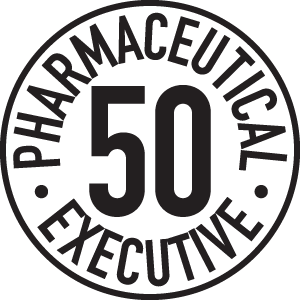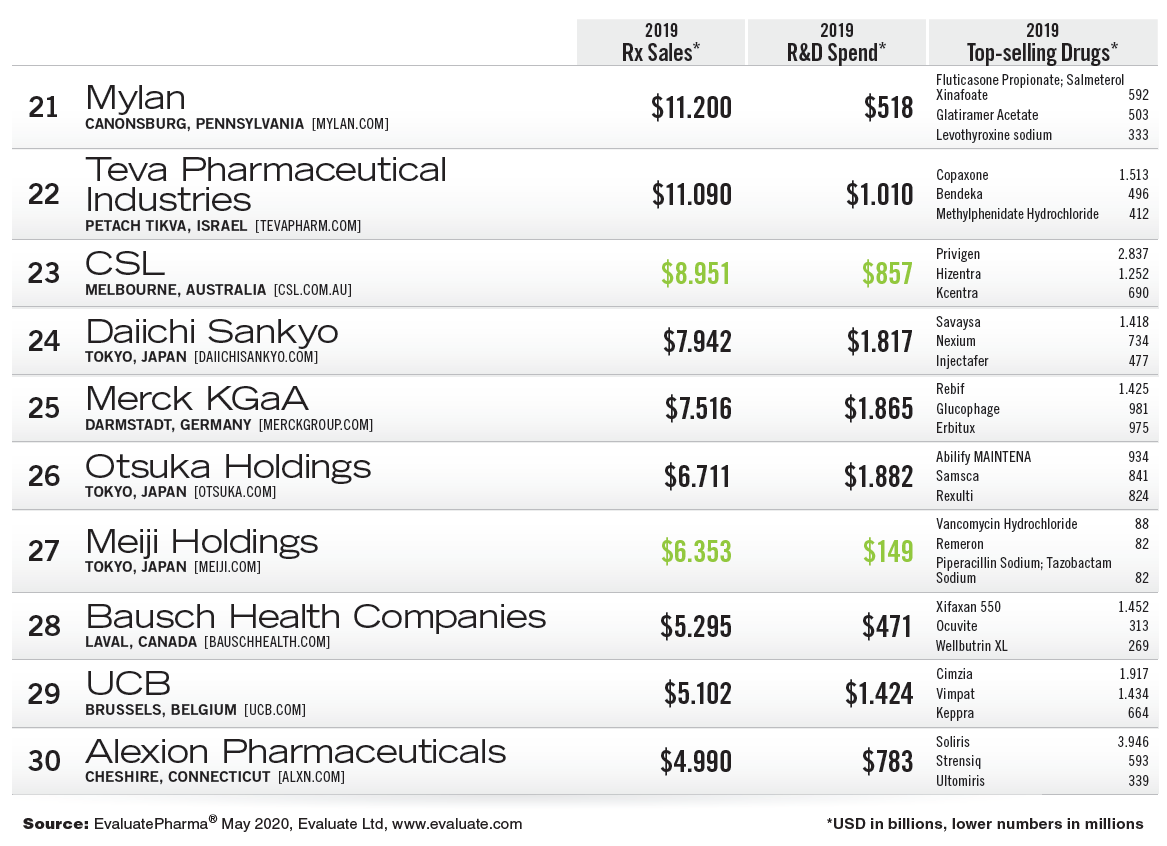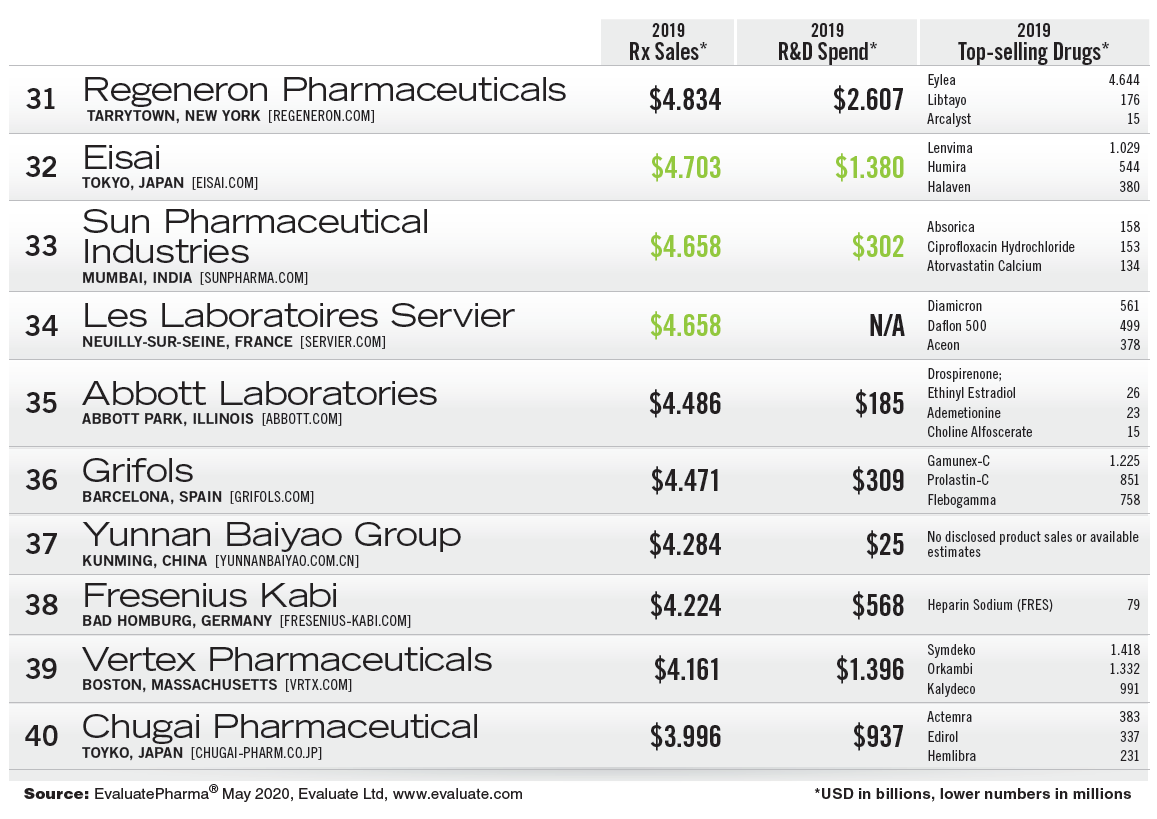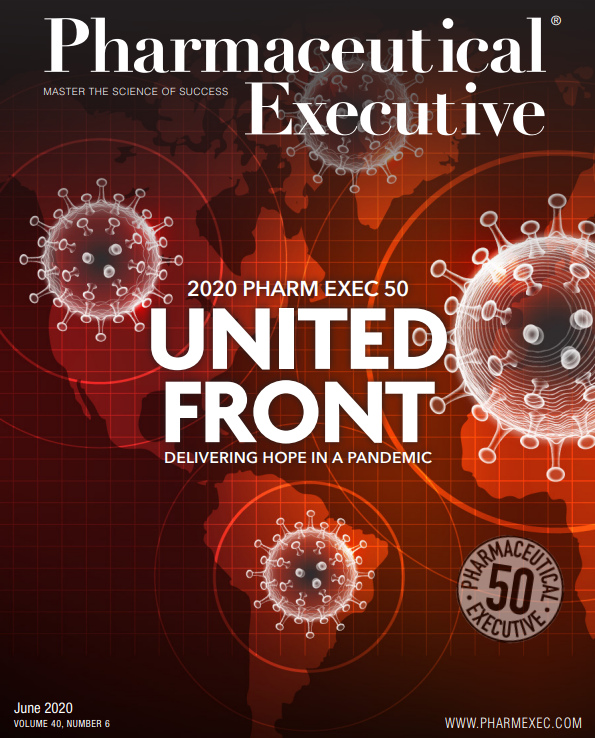Pharm Exec's Top 50 Companies 2020
Pharmaceutical Executive
Our 20th annual listing highlights brand surges, new ranking battles, and M&A-sparked upswings, but in the shadow of COVID-19, a peek behind the numbers also tells another story.

Brand surges, new ranking battles, and M&A-sparked upswings highlight Pharm Exec’s annual listing of the top global biopharma players, but in the shadow of COVID-19, a peek behind the numbers also tells another story-one that reinforces the industry’s wider health mission
With much of the world’s attention today naturally focused on the COVID-19 global crisis-and for governments, the healthcare and medical communities, and others, fixed squarely on critical response, resource, and research efforts to end the pandemic-it may seem an odd juxtaposition to highlight our annual listing of the top 50 biopharma sales producers.
Or could it be that this backdrop actually offers very real context or perspective to this year’s ledger, our 20th? Perhaps never more apparent than today is the scope and force that has long been required to fight not just diseases like cancer or crippling chronic conditions, but unforeseen viral scourges such as COVID-19; Ebola, Swine flu, and HIV/AIDS before; and the next pandemic to come.
After all, many of the companies that made our list are on the front lines in combating the present crisis through avenues such as treatment, outreach, education, and research (see here)-and will likely be for the next one. Some have launched their own initiatives, many are working side by side (e.g., the COVID-19 Therapeutics Accelerator consortium, composed of 12 organizations in our Pharma 50), and others are partnering with government (e.g., Operation Warp Speed, the US Department of Health and Human Services’ pact with AstraZeneca to expedite the development and manufacturing of a coronavirus vaccine developed by Oxford University).
And as yearly prescription drug revenue and R&D spending totals illustrate, it is the capability of these companies, collectively, to generate outputs and sustain investments that ultimately helps turn new science and promising innovation into approved products or important treatment modifications. Pfizer’s announcement early this month to commit $500 million to a series of clinical-stage biotechs-and allow access to Pfizer resources in research, clinical development, and manufacturing-is one such example.
Raising their game
Shaped from the most recent full-year drug revenue tallies, COVID has little influence financially in our latest Pharma 50 rankings. The top 10 positions, however, did experience their biggest shake-up in several years, impacted in part by a pair of mega mergers. Roche, with an increase of 8.3% in Rx sales, moved up one spot to end Pfizer’s four-year reign atop the leaderboard. Avastin, accounting for 15% of the company’s total pharmaceutical revenue, remains Roche’s top seller, but like Herceptin and Rituxan, faces biosimilar competition in the years ahead. As reinforcements emerge, key sales drivers for Roche include multiple sclerosis drug Ocrevus, hemophilia medicine Hemlibra, and cancer treatments Tecentriq and Perjeta. In a rarity for the Pharma 50 in recent history, the same company swept first place in drug revenue and R&D spend, with Roche totaling $10.3 billion in the latter, the only organization to eclipse billion-dollar double-digits in R&D investment.
The data for the Pharma 50 listing was again provided in partnership with life sciences market intelligence firm Evaluate Ltd. Click on the below table for details on how the listings were calculated.
Click to enlarge

Novartis also inched up a spot from our previous rankings, jumping from third to second behind a 6% rise in drug sales. In January, the big pharma completed its $9.7 billion acquisition of The Medicines Company, adding inclisiran, a potential first-in-class cholesterol-lowering therapy (works by harnessing the body’s natural mechanisms for RNA silencing). Novartis’ heart failure drug Entresto grew 74% in the fourth quarter of 2019 to $1.7 billion for the year; it totaled $569 million in the first quarter of 2020. And gene therapy Zolgensma, launched to much attention last June for spinal muscular atrophy, has steadily gained market momentum, as payers haven’t shied away from backing the one-dose treatment despite its hefty price tag.
Rounding out the top five Pharma 50 placeholders are Pfizer, Merck & Co., and Bristol Myers Squibb. Pfizer dropped two spots, as Rx sales decreased 3.6%, due in part to sinking fourth-quarter numbers for its nerve pain drug Lyrica, which has several competing generic versions. Sales of breast cancer treatment Ibrance rose 20.5% last year and Pfizer, which completed its $11.4 billion acquisition of cancer-focused Array BioPharma in July 2019, anticipates continued growth from other brands like Eliquis, Xeljanz, Xtandi, and Inlyta, and from recent and expected launches such as Vyndaqel/Vyndamax, Braftovi, Mektovi, and oncology biosimilars. Merck Rx sales increased 9.5%, spurred by a spike of 54.5%, to $11.1 billion, for cancer immunotherapy Keytruda, as the drug continues to collect approvals for new indications.
Next page: BMS, Takeda's ascension to top 10; Rankings 11-50
BMS zoomed from 11th to fifth, as our list factors in consensus Rx sales estimates for Celgene, officially acquired for $74 billion in November after the deal was announced last January. Celgene’s multiple myeloma stalwart Revlimid leads the combined charge, posting almost $11 billion in sales, while BMS’ Eliquis is next, with a 23% year-over-year increase. COVID-19 demand for the blood thinner, which BMS manufactures in partnership with Pfizer, drove up its revenue 37%, to $2.6 billion, in the first quarter of 2020. Together, BMS and Celgene spent an estimated $9.4 billion in R&D last year, ranking second in this metric, with Johnson & Johnson and Merck manning third and fourth, respectively. Earlier this year, Brand Finance, the independent branded business valuation consultancy, named J&J its 2020 most valuable pharma company, due to J&J’s strong R&D complement, notably for investment in antimicrobials. J&J was one of the first to announce the development of a vaccine for coronavirus during the outbreak in China.
As anticipated, Takeda has muscled into the Pharma 50 top 10 as well, moving from 16th to 10th behind the integration of Shire. The Japanese drugmaker’s Rx revenue rose 67.8% in its first full year following the $62 billion acquisition.

21-30; click to enlarge

While AbbVie (ranked eighth) finally closed its $62 billion purchase of Allergan (ranked 18th) last month, likely elevating AbbVie into the top-five mix in the coming year or two, COVID-19 has stalled the completion of several healthcare-related M&As struck before the pandemic. Evaluate Vantage reports that more recent transactions, like Gilead’s acquisition of cancer biotech Forty Seven in March, while likely not as threatened by the crisis, were made perhaps before the full extent was understood. Nevertheless, M&A uncertainty aside, it seems big pharma remains relatively bullish revenue-wise for the rest of 2020, amid the coronavirus
31-40

(and with the US presidential election looming in November). Evaluate Vantage notes that, as of mid-May, Merck was the only company that cut full-year guidance (by $1.7 billion). Along with BMS, Novartis, GSK, and Lilly were among those reporting significantly increased demand in 2020.
41-50

Outside the top 10, noteworthy observations for the rest of the Pharma 50 field include Japan-based Astellas Pharma moving up four spots to 19th, the additions of four other Asian companies to our list (Meiji Holdings, Japan, 27th; Yunnan Baiyao Group, China, 37th; Shanghai Pharmaceuticals Holding, China, 48th; Aurobindo Pharma, India, 50th), and Regeneron Pharmaceuticals’ climb from 38th to 31st, behind an 18% surge in Rx sales (the New York biotech also upped its R&D spend by 19%, ranking 17th in that metric).
Research mix
Not surprisingly, the COVID-19 pandemic-and resulting healthcare restrictions and state and country quarantine measures-has caused significant disruption to new and ongoing clinical development studies for
non-COVID-related diseases. Research for COVID therapies and vaccines, meanwhile, has been fast and furious, with many projects up against demanding timelines. Phase III clinical trial data, released early this month, for Gilead’s experimental treatment, remdesivir, which has been used under FDA’s emergency use authorization, did reveal efficacy. Results found the drug more effective in patients who received a five-day regimen than those who took remdesivir for twice as long or those on the standard of care. Full
COVID-19 pipeline; click to enlarge

clinical data, measuring other critical endpoints, has not been disclosed yet.
There is research underway for more than 175 vaccine candidates across a wide range of technologies. Moderna Therapeutics’ mRNA-1273 may be the highest-profile prospect at the moment, but big pharma, of course, is heavily involved in these activities, on the development and manufacturing sides. Along with AZ and J&J, other notable vaccine projects have been launched by Merck, Pfizer, Sanofi, and GSK
Regeneron is developing an “antibody cocktail” to treat coronavirus, and Roche’s COVID-19 antibody test, which was given emergency use authorization last month, may be live at more than 200 US commercial and hospital labs in the coming weeks.
Read here for a look at how the public is better grasping biopharma’s drug development efforts during these times.
Michael Christel is Pharm Exec’s Managing Editor. He can be reached at mchristel@mjhlifesciences.com

Applying Porter’s Five Forces to Portfolio Management in Pharmaceutical R&D: A Strategic Roadmap
March 17th 2025The increasing costs and complexity of R&D in the pharmaceutical industry have necessitated the adoption of strategic portfolio management to optimize resource allocation and enhance competitive advantage.
Cell and Gene Therapy Check-in 2024
January 18th 2024Fran Gregory, VP of Emerging Therapies, Cardinal Health discusses her career, how both CAR-T therapies and personalization have been gaining momentum and what kind of progress we expect to see from them, some of the biggest hurdles facing their section of the industry, the importance of patient advocacy and so much more.